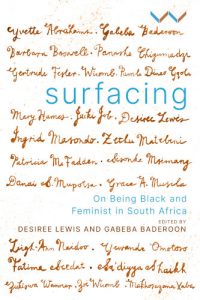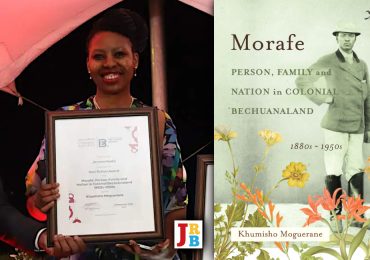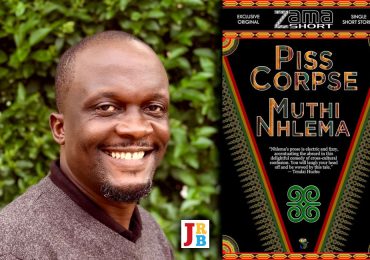The JRB presents an excerpt from a new essay by The JRB Contributing Editor Panashe Chigumadzi, from Surfacing: On Being Black and Feminist in South Africa, a new book edited by Desiree Lewis and Gabeba Baderoon.

Surfacing: On Being Black and Feminist in South Africa
Edited by Desiree Lewis and Gabeba Baderoon
Wits University Press, 2021
Often, because I am a Black woman writer interested in work that centres Black women’s narratives, I am asked to talk about voice. I am often asked about the importance of African women, Black women, telling their own stories. On one occasion, the one that triggered these reflections, I was asked to explore why African women need to write their own stories for themselves and as a gift to future generations.
It is a question that belies the ways in which the dominant culture values speech over silence, presence over absence. The trouble with this bias for speech over silence became apparent to me in the process of writing my second book, These Bones Will Rise Again, which in part entails an attempt to reconstruct the early life of my late paternal grandmother as part of my search for both a personal and national account of Zimbabwe’s liberation history in the wake of Mugabe’s fall. As part of this, I had to speak with and interview women of various generations.
One of them was my maternal grandmother. In the weeks that followed my conversation with Mbuya Chiganze, I spoke to various women related and unrelated to me. Some women were unsure of their authority to speak and referred me instead to others. Other women were militant in their refusal to speak because I’d failed to follow the right protocol. Some did speak to me, but there were certain things they were unwilling to talk about.
Very often I had to fill in the gaps by parsing together facts learned by speaking to other people or through history books because these women were unwilling to talk about certain things I asked about. Through these many conversations Mbuya Chiganze’s words continued to reverberate: Zvimwe hazvibvunzwe. Some things are just not asked. While the queer feminist poet Audre Lorde rightly taught us that our silences will not protect us, these women’s refusal to speak, even when asked, reminded me that silence often remains a state into which the world forces us.
At a time when younger women of my generation have greater access to platforms for telling our stories, it’s often tempting for us to declare: ‘We did not inherit our mother’s silences.’ But how true is this? For one, this ignores the fact that long before us, there were generations of women who did refuse silence and spoke out. More than this, it ignores the many silences that today’s generations carry.
•
A little while before I was to have the conversation with my grandmother, there was something else that had gotten me to start thinking seriously about paying attention to the silence. It was the decisions made by Black women to remain silent in light of the cultural reckoning brought on by the #MeToo movement founded by Tarana Burke in 2006, which developed into a broader movement, following the 2017 use of #MeToo in the wake of the Harvey Weinstein sexual abuse scandal.
In October 2017, it had been a little more than two weeks since a pair of investigative reporters, from the New York Times and the New Yorker, exposed decades of sexual harassment and assault claims against Hollywood mogul Harvey Weinstein, when A-list actress Lupita Nyong’o came forward with her own ordeal with Weinstein. Nyong’o explained her motivation for sharing her story, saying, ‘I felt uncomfortable in my silence, and I wanted to liberate myself from it and contribute to the discussion.’
Before Nyong’o’s story, something that had struck my friend and me was that no Black women had come forward with their own accounts of abuse by Weinstein or any other famous men in Hollywood since the allegations first came out. We were struck by this silence. What did it mean? That no Black women had been abused? We knew that couldn’t be it. We just knew that the answer was something different. We knew from our own experiences—his as a Black queer man, mine as a heterosexual Black woman—that the silence could not be an indication that nothing was happening.
With the help of the vast amount of knowledge created by Black women activists and scholars globally, we were able to make sense of Black women’s apparent silence in that #MeToo moment. Books like Pumla Dineo Gqola’s groundbreaking Rape: A South African Nightmare outline how historical ideas of who ‘can rape’ and who ‘can be raped’ are shaped by aspects such as one’s race, class, gender, sexual orientation, ability, age and profession. Historically, there have been certain bodies that were deemed ‘rape-able’—white women, because they were held as pure and sexually chaste. There were certain bodies that were deemed ‘unrape-able’—Black women, because they were held as dirty and sexually deviant.
Then and today, the logic of who ‘can rape’ and who ‘can be raped’ is further complicated by aspects such as age, class, ability, sexual ability and profession. For example, a sex worker cannot be raped, whilst a baby or an elderly woman is the undisputed victim of rape. Historically, this has meant that the execution of Roman-Dutch law during South Africa’s slavery and colonial years ensured that neither a white nor Black man was ever tried for raping a Black woman. The continuities of this are best seen in former president Jacob Zuma’s high-profile rape trial in 2005. Standing as an ‘unrapeable Black woman’ who dared to accuse one of South Africa’s most powerful men, the late Khwezi, or Fezeka Khuzwayo, was subjected to scrutiny that undermined any sense of her trustworthiness, sexuality and, most of all, her humanity.
It’s no surprise then that even as the #MeToo movement implored the world to believe women, women marginalised because we’re not white, rich, heterosexual, able-bodied or of the ‘right profession’ understood that we were less likely to be believed. We were weighing up the consequences for speaking out differently. Our instinct about differing consequences for speaking out was validated when, after dozens of women accused him, Weinstein directly issued a statement denying Nyong’o’s claims. A few weeks later, he would do the same with Mexican–American actress Salma Hayek’s account. Hayek later stated that she believes the difference in response to herself and Nyong’o is because they’re not white.
More than a year later, a clip from African–American journalist dream hampton’s Surviving R Kelly documentary went viral. In it, Chance the Rapper rationalised working with Kelly, saying, ‘Maybe I didn’t care because I didn’t value the accusers’ stories because they were Black women.’
Later that year, the BBC’s Sex for Grades documentary, led by Nigerian journalist Kiki Mordi, placed the global spotlight on the decades-long battle against sexual harassment at West African universities. The intense debate that followed exposed one of the familiar silencing tools used against women speaking out against abuse from within historically oppressed societies. Detractors made the familiar charge: ‘You are being used by our oppressors to bring down our community.’ This kind of claim echoes the backlash Anita Hill received from the Black community for speaking out against Clarence Thomas in 1991. In the case of Sex for Grades, the victims were supposedly tarnishing the image of their countries by speaking to the BBC, the broadcasting network of their former colonisers.
While neo-colonialism certainly does exist, Mordi’s documentary highlights just how important it is to have our own empowered local media spaces that can override the pressure to remain silent even in the face of overwhelming evidence. Importantly, her documentary forces us to ask: who else has been silenced? What other abuses have our leaders helped bury by limiting local press freedoms and infrastructure?
•
I want to invite us to think about hearing the silences. To understand that what is not said is just as important as what is said.
I want to invite us to interrogate how we hear silences that echo in the aftermath of traumatic pasts and presents.
Silences have frequencies.
I want us to ask, ‘How can we learn to hear silences that echo loudly, softly, or in code?’
•
To begin with, we need to pay attention to the ways in which our silences are shaped by race, class, gender, sexuality, ability, religion and nationality. It is important to pay attention to the power dynamics that play out between different bodies across history.
We need to be attentive to the many forms that silence can take. At the end of 2017, Dr Sindi van Zyl, a renowned Black woman medical doctor, who has made her mark by sharing HIV-related knowledge and other health information with the public on social media and other platforms, shared an anecdote on Twitter about why she mostly refers Black patients to Black doctors. One of the most important reasons she gave was communication. Through her post, she relayed a conversation she had with a 65-year-old Black woman patient, from whom she needed to draw out a sexual history. To do this, Dr Van Zyl understood that she needed tact. The conversation, shared on Twitter, went like this:
[Dr Van Zyl]: Mama are you in a relationship?
Mama: No. My husband died 15 years ago
[Dr Van Zyl]: Do you have a ‘friend’?
Mama: Yes I do have a friend
[Dr Van Zyl]: How often do you ‘visit’ your ‘friend’?
Mama: Mostly month end
[Dr Van Zyl]: Do you use condoms? Yes? No? Sometimes
Mama: Sometimes.
Dr Van Zyl understood: some things are just not asked. Without crudely asking, ‘Mama, are you sexually active?’ she got the crucial information she needed. Another doctor without her cultural awareness and knowledge of Zulu would have missed Mama’s indirect way of speaking and simply moved on to the next question. Dr Van Zyl appreciated that AboMama don’t have boyfriends or sides. They have ‘abangani’—‘friends’.
What Dr Van Zyl highlights here is the importance of paying attention to the silences that are created by language and cultural differences. This is particularly true for our post-colonial situation where those who hold power are often unable to speak or even hear any of South Africa’s indigenous languages. Many will go to great lengths to learn French or even Mandarin before ever being able to go beyond sanibonani (hello), celi’amanzi (1) or, if we are particularly unfortunate, nkalakatha. (2) Beyond transmitting functional information, our languages carry our experiences, our values, our world views. If you cannot understand our languages, you cannot hear us.
[Editor’s note: Dr. van Zyl died on the 10th of April, causing a national outpouring of grief.]Importantly, these coded silences exist not just between isiZulu and English, Setswana and Afrikaans; they are also embedded in the modes of speech and languages that marginalised people use as a means of survival. This can take the form of languages queer people may use to communicate with and identify each other in places where there are threats such as social exclusion, prosecution and even death. Often I, as a heterosexual woman, miss many cues when I’m following conversations among my queer friends. One way I attempt to overcome this is by engaging the creative works and scholarship of people in different communities from mine. It’s a well-worn cliché that reading is a way to build empathy and immerse yourself in the worlds of others who aren’t like you. We can extend the work of empathy building beyond literature. We need to ask ourselves: Are we watching the experimental film directed by an undocumented migrant from Malawi? Are we reading the sonnet written by a poor woman from Soweto? Are we listening to the dance album produced by the differently abled man from Harare? Are we watching the one-woman play written by a trans woman from Brixton? Are we interested in hearing, and feeling our way through, the language-worlds inhabited by those different from us?
More than this, more than simply appreciating coded silences, we must appreciate why they’ve come to exist in the very first place and fight against this. Without this, we’re only reinforcing the very silence that we’re asking each other to break.
•
We need to pay attention to the ways in which we can use our imaginations to hear the silence. For me, as a young Black woman writer who has sought to write about the early life of my late grandmother, with precious few records of that time, I have been particularly inspired by the ways Black women writers have used fiction and the imagination to overcome great historical silences in the face of great historical trauma.
South Africa’s history contains silences where the voices of its enslaved people should have figured. As slaves were for the most part denied literacy, let alone access to the printing press, there was seemingly no chance for them to develop a literary voice, a written voice, a record for future generations. The repression of the slave voice has contributed to the creation of a South African history that is a ‘master’s history’ in which slavery and emancipation in the nineteenth-century Cape Colony were undramatic and inconsequential. In the absence of accounts from the mouths of South Africa’s enslaved, we are left to interrogate our collective memory and ask: What stays unheard by force of repression? What stays unsaid by force of resistance?
To answer these silences, Toni Morrison’s concept of ‘re-memory’ invites us to ‘journey to a site to see what remains were left behind and to reconstruct the world that these remains imply’ in order to re-humanise those who have been ‘disremembered and unaccounted for’.
Rayda Jacobs’s The Slave Book and Yvette Christiansë’s Unconfessed are two such novels that recover and re-memory the ‘dis-remembered’ past of the Cape Colony, through an imaginative revisiting of the fragments of this history. The Slave Book, which takes its title from the register that stipulated the codes controlling enslaved people at the Cape of Good Hope, is set against the backdrop of the 1834 abolition of slavery and the subsequent four-year period of forced apprenticeship for the emancipated. The novel excavates the years preceding the emancipation, through the narrative of Salamah, his wife Noria, and her daughters Sangora and Somiela. Sangora and Somiela are separated from Noria when they are sold to the De Villiers family at a slave auction. At the heart of the story is the love affair between Somiela, who is of mixed heritage, and the foreman Harman Kloot, a white vryburger (free man) who is later revealed also to be of mixed ancestry. Through this union, Jacobs destabilises racial and sexual boundaries central to the slavocratic society in which sexual abuse was as routine a weapon of control as the whip and chain.
Yvette Christiansë’s Unconfessed centres the silences at the heart of the life of the historical figure Sila van den Kaap, a slave woman who was incarcerated for the kindermoord, child murder, of her nine-year-old son, Baro. Her life is spared because she is pregnant. Sila is later sent to Robben Island to serve an extended sentence of 14 years, after which her fate is unknown. The fact of her having taken her son’s life is unquestioned, but whether this constitutes a crime is contested.
‘I could not say as they wanted me to say,’ says Sila. Throughout the novel, she refuses to confess to the crime for which she has been tried. Christiansë then dedicates the narrative to re-memorying an enslaved woman who uses the act of kindermoord to enact motherhood by controlling the circumstances of her child’s life to protect him from the pain of enslavement. Towards the end of the novel, Sila laments:
[t]he daughters and sons of my generations will say, we are not people, we are things … And I will be weeping in my grave … hungering after other people’s children, for my children will be running behind me, forgotten too as their children’s children, those rocks who were once people, smash and smash some terrible future into shape.
Together, The Slave Book and Unconfessed offer a haunting, poignant poetics that foregrounds language, voice and presence in order to re-memory the silences of enslaved women. In the face of great historical silences, Black women’s imaginative works are wreaths lain on the graves of ancestors so that they may not weep: so that they know, we, the daughters and sons of their generations say: we are not things, we are people.
•
For me, it has been Black women writing about women silenced by history that’s taught me the delicate art of storying the silence without speaking over it (3). The generations of women I spent time with as I tried to reimagine my late paternal grandmother’s early life have helped me understand: silence need not represent a dead end, but rather, a beginning.
•
After that initial night in my surviving grandmother’s bedroom, I decided to put my questions away and just focus on being with her.
Before then, I’d never really spent much time alone with Mbuya. Language was often a barrier. As I work to reclaim my mother tongue, Shona, I’m struck by the fact that the word kunzwa not only means ‘to hear’; it also means ‘to feel’, ‘to understand’. I thought about hearing as feeling and understanding as the silences between my grandmother and I became an opportunity for pause, for deep introspection, deep imagination and hard work at creating a new language between us—one of feeling and understanding. When I least expected it—perhaps in the middle of tending to her flowers or walking to church—Mbuya shared things with me I hadn’t even thought to ask about.
It was only through this space, a space created by a respect for my grandmother’s silences, that I was finally able to hear her.
1. ‘Can I have some water?’ [Zulu].
2. ‘Top dog’ in isiZulu. The word was made famous among white South Africans by the late South African kwaito star Mandoza, whose song ‘Nkalakatha’ was a crossover hit in the 2000s.
3. As Victoria Adukwei Bulley writes of Saidiya Hartman’s method of critical fabulation: ‘Her mastery, however, is in how she does this, how her encounters with archival material—inventories documenting the enslaved, photographs, songs, names, or the sheer lack of them—become stimuli for a narrative technique that stories the silence of loss without speaking over it.’
Adukwei Bulley, Victoria. ‘Interview with Saidiya Hartman.’ The White Review. June 2020. https://www.thewhitereview.org/feature/interview-with-saidiya-hartman/
~~~
Contributing Editor Panashe Chigumadzi is an essayist, editor and fiction writer. Her debut novel Sweet Medicine won the 2016 K Sello Duiker Literary Award. Her second book, These Bones Will Rise Again, was shortlisted for the 2019 Alan Paton Award for Non-fiction. She was the founding editor of Vanguard magazine. Her work has been featured in periodicals including The Guardian, Chimurenga, Africa Is a Country, Transition, Washington Post, New York Times and Die Zeit. Follow her on Twitter.
Author image: Jamie Intwari/Composite: The JRB
~~~
Publisher information
‘Decolonial feminism in practice and in its finest representation, this is a much-needed addition to the library of materials on Black Feminism in a global context. Surfacing: On Being Black and Feminist in South Africa moves us rapidly out of the norm that privileges work that comes out from the West often with the justification that it is difficult to find available material. Teaching, studying, and writing about Black Feminist Theories remains incomplete without the intellectual contributions of Black women in diverse locations. Here are the voices of Black Feminists from Southern Africa who cover all topics from being Black lesbian and feminist to living life as a Black radical feminist, to the challenges of writing feminist biography and much more.’— Carole Boyce-Davies, author of Left of Karl Marx: The Political Life of Black Feminist Claudia Jones and is a professor in Africana Studies and Literatures in English at Cornell University
‘A beautiful book that brings together some of South Africa’s finest, most innovative writers working across a multitude of forms. Here, the personal essay and artistic reflection, the conversational interview and research paper, all work to engage complex questions around creativity, race, feminism, agency and history with depth, care, daring, provocation, wit and intellectual rigour. Surfacing promises to be treasured as much for its brilliant engagements and insights, as for the wonderful connectivity and solidarity it makes space for.’— Nadia Davids, Author
What do African feminist traditions that exist outside the canon look and feel like? What complex cultural logics are at work outside the centres of power? How do spirituality and feminism influence each other? What are the histories and experiences of queer Africans? What imaginative forms can feminist activism take?
Surfacing: On Being Black and Feminist in South Africa is the first collection of essays dedicated to contemporary Black South African feminist perspectives. Leading feminist theorist, Desiree Lewis, and poet and feminist scholar, Gabeba Baderoon, have curated contributions by some of the finest writers and thought leaders. Radical polemic sits side by side with personal essays, and critical theory coexists with rich and stirring life histories. By including writings by Patricia McFadden, Panashe Chigumadzi, Sisonke Msimang, Zukiswa Wanner, Yewande Omotoso, Zoë Wicomb and Pumla Dineo Gqola alongside emerging thinkers, activists and creative practitioners, the collection demonstrates a dazzling range of feminist voices.
The writers in these pages use creative expression, photography and poetry in eclectic, interdisciplinary ways to unearth and interrogate representations of Blackness, sexuality, girlhood, history, divinity, and other themes. Surfacing is indispensable to anyone interested in feminism from Africa, which its contributors show in vivid and challenging conversation with the rest of the world. It will appeal to a diverse audience of students, activists, critical thinkers, academics and artists.






What an interesting read! Thanks, Panashe Chigumadzi!